| URLs in this document have been updated. Links enclosed in {curly brackets} have been changed. If a replacement link was located, the new URL was added and the link is active; if a new site could not be identified, the broken link was removed. |
A Web Database to Manage and Organize ANSI Standards Collections
Engineering Librarian
Valley Libraries
Oregon State University
John.Matylonek@orst.edu
Programmer
Webworks
Oregon State University
peasley@engr.orst.edu
Abstract
A custom designed web database to process American National Institute Standards extends the functionality of the online catalog by providing an online searchable index of specific ANSI standards. The database is accessible through the online catalog via the ANSI cataloging record. Other services associated with the database provide user education and retrieval options for those standards not owned by the library. Information to download and implement the database is provided.
Introduction
American National Standards Institute (ANSI) collections of standards are difficult to organize and manage in technical libraries. Many catalog departments will not treat them as monographs. Often they are represented as serial records that are not as helpful because information about individual standards is not available (Taylor 1999). Reference departments often try to represent the collection without the use of the online catalog. Often, a user or librarian must use a constantly updated printed list, or specially marked generic subject/numeric indexes to determine availability in the local collection. Sometimes, one does not know if a standard is available till the shelves are physically checked. The use of a custom designed web database can help in the management and identification of locally owned ANSI standards. Online catalog records can link to the database (figure 1) thus enhancing access to the standards collection. If your library does not catalog standards as monographs, then a web accessible database of locally owned ANSI standards may assist in their identification and retrieval. By linking the database to the local collection through an online catalog record access to the standards can be enhanced.
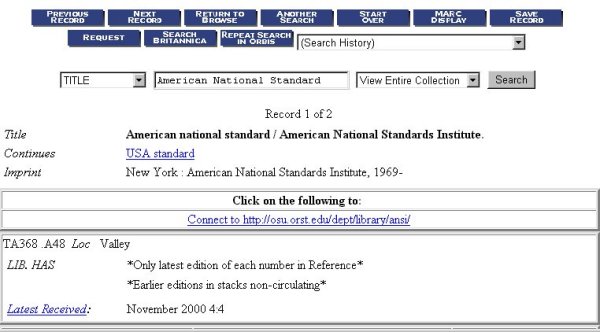
Creation of the Web-Accessible Standards Database
Valley Library at Oregon State University maintains a collection of ANSI standards that is in need of constant attention. Standards are often revised or superseded by newer standards. Some are canceled and become inactive. The princeton box sets in which they are stored are often in danger of overflowing and making designation ranges inaccurate. The engineering librarian decided that the culling of "archival" standards from active ones and the processing of new ones into the collection could be assisted by a database inventory of all the standards. In the process of inventory, new boxes would be added, designation ranges made accurate, and old superseded and canceled standards placed in a separate off-campus storage collection. Furthermore, a web-accessible database of current standards would greatly improve access by providing access through the online catalog.Current web technology provides many alternate approaches for the creation of web accessible databases. ColdFusion is a web interactive form mark-up language licensed by Allaire Corporation. It was chosen as the medium to create the web interfaces for the database. The popularity of the language and its central support by the university web service was the main criterion in using this platform. ColdFusion, used in conjunction with the SQL database server, provides an almost ideal platform for the creation of the database. A student programmer was retained to do the coding. The programmer worked with the engineering librarian, who provided overall specifications. Student library workers provided specific requests for design features that mirrored the actual work procedures in the record input stage of the project. The result is a database created specifically for the processing of ANSI standards in technical libraries.
Organization of the Database
There are three levels of access into the database: 1) a user search page 2) a worker entry page, and 3) an administrator's page. Library users and front-line reference librarians use the search page comprised of eight keyword searchable fields. The worker entry level of the web database is organized to reflect the processing of standard records by teams of staff into virtual princeton box sets. The administrator's level (Figure 2) has global change and user rights/access functionality.
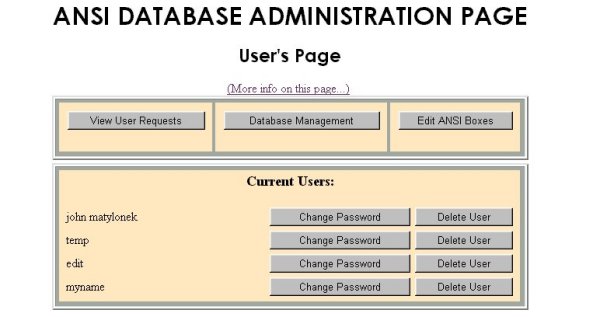
Search and Retrieval of Standards
The user search page (Figure 3) can be accessed through several web links including the online catalog record, a link under notable collections on the library web site, and the engineering subject resource guide. Eight simple fields provide multiple points of access: designation, title, status, date of designation, approved by, revision history, location, and description. The most typical information given as clue to a standard's existence is an imprecise title, phrase or a part of a designation number. The database accepts partial input of text strings into each field and returns all records containing the string. Although this not as powerful as keyword searching between fields, it is usually sufficiently powerful to identify most items. For instance, inputting the term "gear" into the database retrieves a browsable list of 26 items. A button next to each item generates the full record. The designation, status, and location provide all the necessary information to retrieve the print copy from the collection.
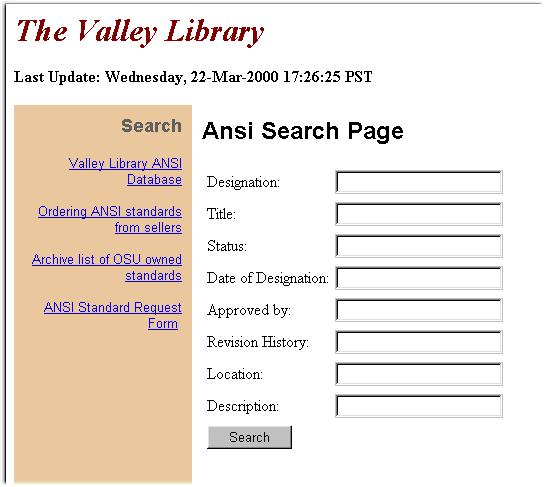
Storage of ANSI Standards
The ANSI collection at Valley Library is organized into princeton boxes. There are two sets of collections of ANSI standards -- the current or active standards in force from ANSI and the superseded, canceled or withdrawn standards. These latter standards are housed in the "ANSI Archive Collection" in an off campus storage facility. The active standards are shelved under TA368 .A48 in the reference collection near the main service desks of the library. This arrangement assumes old standards are often of use to attorneys, patent agents, engineers and other professionals in retrospective analysis. Their lower usage does not justify on campus library shelving.
Processing Standards into the Database
Like many university libraries, much of the shelving and processing work is done by students and classified staff. This project involved extensive retrospective input of acquired standards. The database was designed to allow teams of students to pick up where others had left off and to revise box designations (Figure 4) as space was required. As new workers are assigned, the librarian supervisor of the database provides user name and passwords via the administrator page.
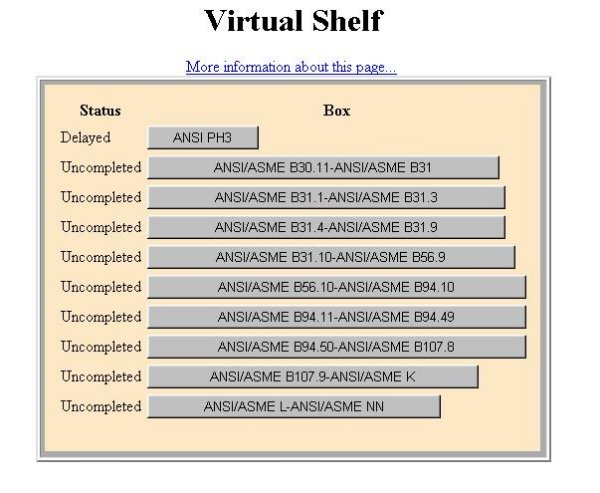
The record entry interface design (Figure 5) mirrors the work procedures of the staff that perform the record input and the physical boxes in which the standards are shelved. This makes it easy for one worker to pick up where the previous has left off. This arrangement allows several independent workers to coordinate work without much supervision or communication, minimizing mistakes that cause gaps or duplicates in the database. The supervisor gauges and controls the quality of the work via global and single purge, delete or refresh features.
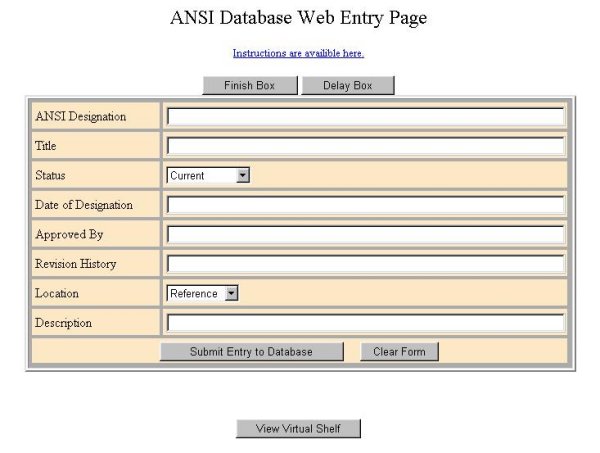
Providing Enhanced Services Surrounding Standards
The database is the core tool that users and librarians use to identify and retrieve locally housed ANSI standards. Despite the better access to ANSI standards, many librarians and users are not familiar with range of options of acquiring standards. A web page (Figure 6) was created to provide some education surrounding industry standards. The web page has a link to the local database with a brief explanation of what standards are, tips on how to interpret requests, links to commercial standards databases and a form to request standards that the library does not own. With this last piece, all subject specialists, not just the engineering specialist can help patrons locate ANSI standards.
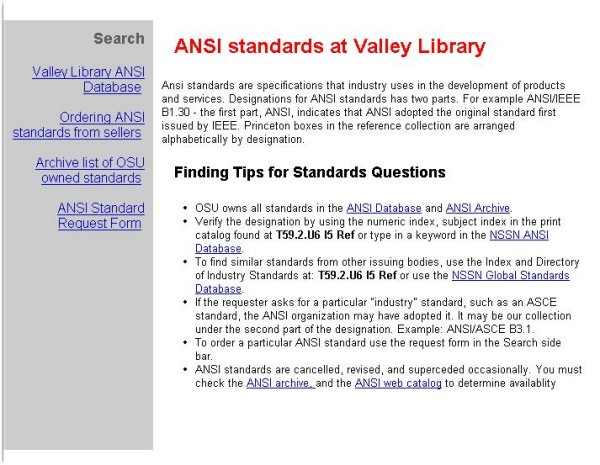
Future Possibilities
Web accessible databases make it extremely convenient for the sharing of standards holdings information between cooperating libraries. With some slight modifications and joint upkeep agreements, a union database of standards held by regional libraries could be created. This scheme would have each library input their specific standards, rather than just collection set information as found in national union catalogs.
Trying it Out
The standards services web page at {http://osulibrary.orst.edu/ansi/} provides a convenient access point to the publicly accessible parts of the system. For questions about the database you may contact john.matylonek@orst.edu for further information.
Resources Needed to Implement
In order to start the database at your library you will need to have access to a web server configured for ColdFusion, a code that creates web interfaces for databases. Your web master/system administrator will best know how to do this. Actual implementation specifically requires the ANSI ColdFusion code, a database to which cold fusion can talk, and your web master/system administrator's help in configuring the database. Although editing the code for enhancements and modifications is possible (the code has been generously commented) we cannot provide specific technical support for either loading or modifying the code. However, bugs in the software are encouraged to be reported to Maren Peasley at peasley@engr.orst.edu. The code can be downloaded from: {http://osulibrary.orst.edu/ansi/}
Bibliography
Taylor, D. 1999. Standards collection development in an academic library. Collection Building 18(4): 148-152.ColdFusion product information. [Online] Available: {http://www.adobe.com/products/coldfusion/} [May 7, 2001]
| Previous | Contents | Next |
